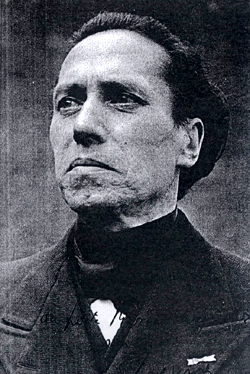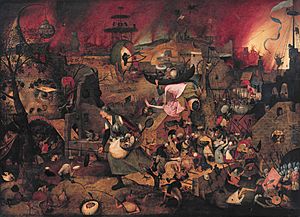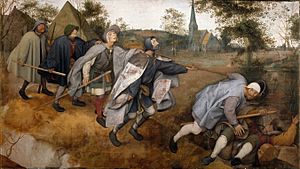Michel de Ghelderode facts for kids
Quick facts for kids
Michel de Ghelderode
|
|
|---|---|
 |
|
| Born |
Adhémar-Adolphe-Louis Martens
3 April 1898 |
| Died | 1 April 1962 (aged 63) Brussels, Belgium
|
| Nationality | Belgian |
| Other names | Philostene Costenoble Jac Nolan Babylas |
| Occupation | dramatist |
| Spouse(s) | Jeanne-Françoise Gérard (d.1980) |
Michel de Ghelderode (born Adémar Adolphe Louis Martens, 3 April 1898 – 1 April 1962) was a Belgian writer of plays and short stories. He was known for his unique and often unusual style. He wrote in French, even though he was from Flanders, a Dutch-speaking part of Belgium. His works often explored strong human feelings and experiences, from sadness and decay to deep religious joy. He also wrote many letters.
Contents
About Michel de Ghelderode
Michel de Ghelderode was born in Brussels, Belgium, in 1898. His father, Henri-Louis Martens, worked as a royal archivist, which meant he took care of important historical documents for the king. Michel later followed in his father's footsteps.
His mother, Jeanne-Marie Rans, had once planned to become a nun. Even after having four children, she kept some of her spiritual ways. This greatly influenced Michel's plays. For example, one of her stories about a child mistakenly buried alive inspired his play Mademoiselle Jaire (1934).
Michel served in the military from 1919 to 1921. In 1924, he married Jeanne-Françoise Gérard.
From 1930 onwards, Ghelderode became more private and stayed home a lot. He often suffered from asthma, a breathing illness. When he was about sixteen, he became very sick with typhus. During this time, he had a vision of a "Lady" who told him he would die at 63. He actually passed away in 1962, just two days before his 64th birthday. He is buried in the Laeken Cemetery in Brussels.
Artistic Inspirations
Michel de Ghelderode's ideas about theater were very similar to those of another writer, Antonin Artaud. Artaud wrote a famous book called The Theatre and Its Double in 1938. Both Ghelderode and Artaud believed that theater could show the deep, dream-like parts of the human mind. They both found inspiration in the strange and imaginative paintings of Flemish artists like Hieronymus Bosch and Pieter Bruegel the Elder.
Ghelderode called Brueghel his "foster father" because he felt so connected to his art. He even wrote plays based on Brueghel's paintings. He once said that Brueghel's painting "Dulle Griet" showed a whole way of looking at the world. Artaud also talked about this same painting to explain his ideas about "theatre of cruelty," which aimed to shock and challenge audiences.
Ghelderode loved the folk traditions and culture of Flanders, where he was born. These traditions are a big part of his plays and stories. He felt that Flemish people lived in a very imaginative world, but also saw things very realistically. He believed his writing continued this Flemish tradition.
Other artists who influenced Ghelderode included puppet theater, Italian commedia dell'arte (a type of comedy theater), and medieval Flanders. He was also inspired by painters like Jacob Jordaens and the Teniers, as well as the Belgian artist James Ensor, who painted dark and unusual scenes. The novelist Georges Eekhoud was also an influence.
Many of Ghelderode's plays are based on Brueghel's paintings. For example, his play The Blind Men (Les Aveugles, 1933) comes from Brueghel's The Parable of the Blind. The Magpie on the Gallows (La Pie sur le Gibet, 1935) was inspired by Brueghel's The Merry Way to the Gallows. Even The Strange Rider (Le Cavalier Bizarre, 1920) was inspired by Brueghel's art, though not one specific painting.
Michel de Ghelderode's Career
Ghelderode was a very active writer. He wrote over 60 plays, 100 stories, many articles about art and folklore, and more than 20,000 letters.
He started writing plays in French in 1916. His first play, Death Looks In at the Window, was performed in 1918. The Beasts' Meal followed in 1919.
In 1921 and 1922, he worked as a professor but had to quit due to poor health. The next year, he worked in a bookstore. In 1923, Ghelderode got a job as an archives editor in Schaerbeek, where he worked until 1945.
In 1924, he began writing for magazines like La Flandre littéraire. He also wrote plays for a puppet theater called Les Marionnettes de la Renaissance d'Occident. Ghelderode started directing plays again in 1925, working with a Dutch director named Johan de Meester until 1930.
One of his most famous plays is Escurial (1927). It is often performed and is known for its unique style, showing influences from German Expressionism and Symbolism. He wrote Pantagleize (1929) for a Flemish comedian named Renaat Verheyen, who sadly died young shortly after playing the main role.
Ghelderode stopped writing plays completely in 1939. Between 1946 and 1953, he wrote for a newspaper called Le Journal de Bruges. In 1949, some of his plays, especially Chronicles of Hell, caused a big stir in Paris. Some people loved them, while others were very angry. This made him famous, but also controversial.
Themes and Writing Style
Ghelderode created a unique and sometimes unsettling world in his plays. This world is often filled with strange characters like puppets, devils, masks, and mysterious old women. His stories create a spooky and unusual feeling, even if they don't have anything truly scary happening.
Many of Ghelderode's plays show a strong dislike for strict religious rules, but they still have a sense of spirituality. In his plays, religion is often respected, but not always strictly followed.
According to Oscar G. Brockett, Ghelderode's works are similar to those of other unique artists like Alfred Jarry and the expressionists. His ideas are also like those of Antonin Artaud. Ghelderode often showed people as beings whose physical desires were stronger than their spiritual side. His works often touch on themes of decay, death, and harshness. However, behind these themes, he often hinted at a criticism of materialism and a call for people to change their ways.
Ghelderode was one of the first playwrights to use the idea of "total theater." This means he tried to appeal to all the senses – sight, sound, and emotions – to make the audience think. As a pioneer of this style, Ghelderode had a big impact on French theater history. Even though many of his plays have been translated into English, they are not performed very often in English-speaking countries.
In 1957, filmmakers Luc de Heusch and Jean Raine made a short film about Ghelderode. He appears at the end of the film, at the Royal Theatre Toone, a famous puppet theater in Brussels.
Other Names Used
Michel de Ghelderode was born with the name Adhémar-Adolphe-Louis Martens. He legally changed his name later. He also used other pen names (writing names) like Philostene Costenoble, Jac Nolan, and Babylas.
Music and Opera Adaptations
Ghelderode's play La Balade du Grand Macabre (1934) was used as the story for an opera called Le Grand Macabre. This opera was written by the composer György Ligeti between 1974 and 1977.
Works by Michel de Ghelderode
Plays
- Death Looks in the Window (1918)
- The Beasts' Meal (1918)
- Piet Bouteille (1920)
- The Strange Rider (1920 or 1924)
- Blockheads (1924)
- Miracle in the Suburb (1924)
- The Farce of Death Who Almost Died (1925)
- The Old Men (1925)
- The Death of Doctor Faust (1926)
- Images from the Life of Saint Francis of Assisi (1926)
- Venus (1927)
- Escurial (1927)
- Christopher Columbus (1927)
- The Transfiguration at the Circus (1927)
- Dreams Drowning (1928)
- A Night of Pity (1928)
- Three Actors, a Drama... (1928)
- Don Juan (1928)
- Barabbas (1928)
- Chronicles of Hell (1929)
- Pantagleize (1929)
- Atlantic (1930)
- The One Who Sold the Hanging Rope (1930)
- Godelieve (1930)
- Caroline's Household (1930)
- The Sleep of Reason (1930)
- Liar's Club (1931)
- The Tin-Plated Crown (1931)
- Red Magic (1931)
- The Blind Men (1933)
- The Star Thief (1931)
- The Sorrow of Hamlet (1932)
- Public Life of Pantagleize (1932?)
- The Great Temptation of Saint Anthony (1932)
- Anatomical Play (1932)
- The Relic Dealer (1932)
- Casimir of the Academy... (1932)
- Paradise Almost Lost (1932)
- Genealogy (1932)
- Rainbow (1933)
- The Siege of Ostend (1933)
- Swane (Opera, 1933)
- Pleasure of Love (1933)
- The Sun Sets (1933)
- Adrian and Jusemina (1934)
- The Parrot of Charles V (1934)
- Ostend Masks (1934)
- Little Drama (1934)
- The Ballad of the Grand Macabre (1934)
- Lord Halewyn (1934)
- Mademoiselle Jaïre (1934)
- Hop Signor! (1935)
- Exit the Actor (1935)
- The Old Trooper (1935)
- The Singular Death of Messire Ulenspigel (1935)
- The Farce of Shadows (1936)
- The Magpie on the Gallows (1937)
- Pantagleize is an Angel (1938, draft)
- The Little Girl with Wooden Hands (1939)
- Scenes from the life of a Bohemian: Franz Schubert (1941)
- School for Buffoons (1942)
- The Legend of the Sacristan (1942, draft)
- The Triumphant Parrot (1943)
- For They Know Not What They Do (1950)
- The Madness of Hugo van der Goes (1951)
- Marie the Miserable (1952)
- The Touching and Very Moral Heavenly Tribulation... (1960, unfinished)
- Angelic Chorus (1962)
Plays for Marionettes (Puppets)
- The Mystery of the Passion of Our Lord Jesus Christ (1924)
- The Massacre of the Innocents (1926)
- Duvelor, or the Farce of the Old Devil (1925)
- The Night Watch (1932)
- The Night in May (1932)
- The Women at the Tomb (1933)
- Of a Devil Who Preached Wonders (1934)
Poetry
- The Horn of Abundance (1925)
Prose (Stories and Essays)
- Journey Around My Flanders (1921)
- The Comic History of Emperor Charles (1922)
- The Catholic Stop (1922)
- The Man under the Uniform (1923)
- The Man with the Mustache of Gold (1931)
- Spells (1941)
- My Statues (1943)
- Things and People from Home (1943, 2 volumes)
- Flanders is a Dream (1953)
- The Ostend Interviews (1956)
Images for kids
See also
 In Spanish: Michel de Ghelderode para niños
In Spanish: Michel de Ghelderode para niños






